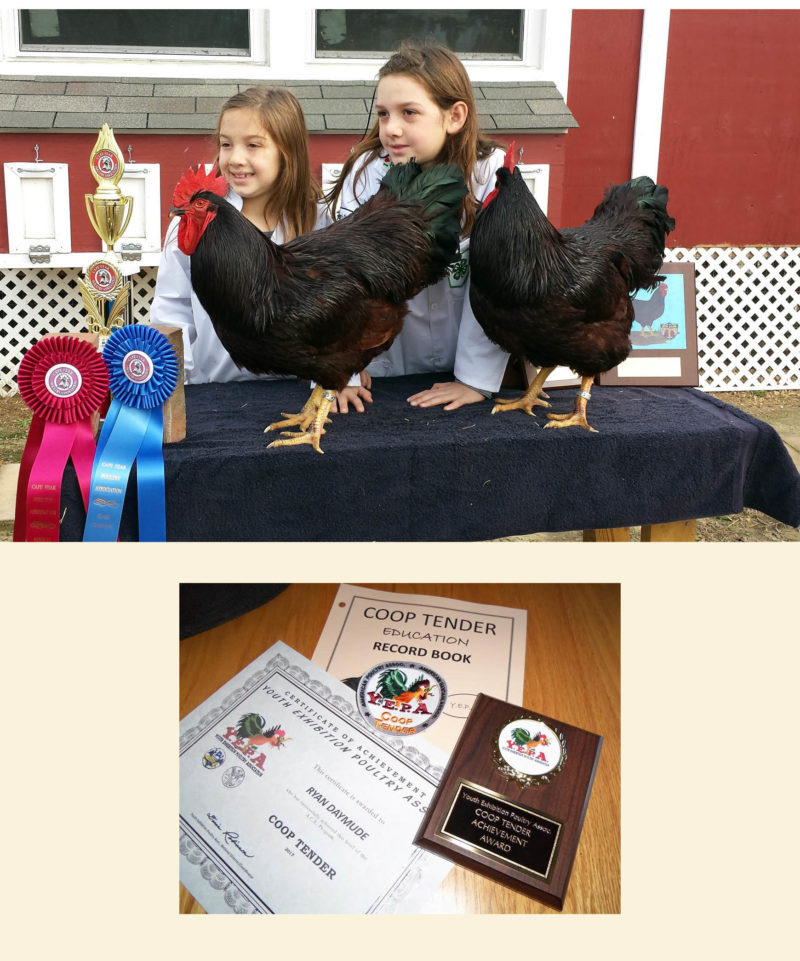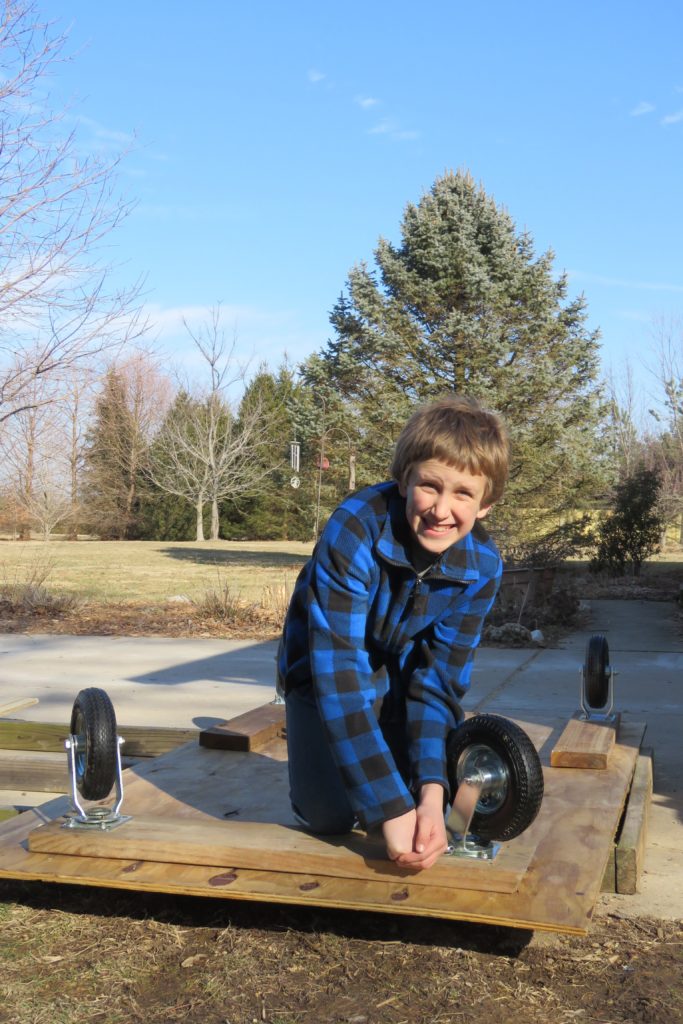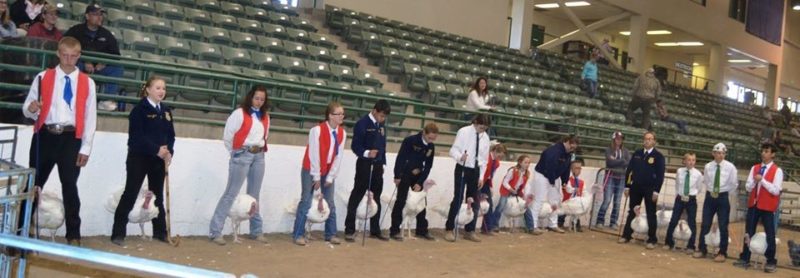Christine Heinrichs outlines some of the many different poultry organizations available nationwide to help young folks learn more about poultry care and feeding.
Kids are attracted to chickens from the first time they hear the story of the Little Red Hen. Poultry organizations can help them build those attractions into solid life paths. Additionally, poultry can occupy young people at home during COVID-19 restrictions.
APA-ABA
The American Poultry Association (APA) and the American Bantam Association (ABA) are the primary national poultry exhibition organizations. Their goal is improvement in domestic fowl and advocating for purebred poultry. The APA includes waterfowl, turkeys, guineafowl, and both large chickens and bantams. The ABA focuses on chickens and ducks. Local clubs affiliate with the APA and sponsor local shows, and specialty breed organizations hold competition meets for their breed within the show.

Young girl with her chicken getting ready to show. Photo by Gloria Montero.
Joining the national organizations gives young people an entry point and direction to get more involved with poultry.
Youth Exhibition Poultry Association
The Youth Exhibition Poultry Association (YEPA) is another organization that offers young people programs to get more involved with poultry. YEPA was created in 1995 under the APA and ABA and became an independent organization in 2015. The A.C.E. Program (Activities, Competition, Education) is one of the most popular. Kids get started as young as eight years old, and can continue to build their knowledge through four levels, to age 21, at which point they can apprentice to become poultry judges. “They learn the basics about pure bred, exhibition poultry,” says Doris Robinson, director of YEPA.

Girls showing their prized birds; awards and information by YEPA. Photo by Doris Robinson.
The program requires members to learn about their breed and others, history, husbandry, candling and hatching eggs, health, and medications. They keep notebooks and Health Maintenance Records of their flocks, and they track income and expenses to arrive at a financial summary of their project. “The kids have to work extremely hard,” says Robinson. “It’s a great reference for kids who want to go to college in poultry. They go into adulthood with a lot of knowledge.”
The APA elected Mark Podgwaite as president in March. He follows John Monaco, with whom he served since 2016 as vice president. Monaco led the APA to adopt more technology during the past four years, using it to track the point system faster and more accurately, and to record and livestream meetings. Membership services allow directors to communicate better with members. “We’re sort of old fashioned, but we know that we have to bring the organization into the modern age,” Monaco says. “We need to think to the future, but remember the past.”
Podgwaite would like experienced APA members to connect with young people as mentors. He plans for the APA to increase its financial support to clubs that sponsor shows. “We recognize that it’s an extra added expense to hold these meets,” he says.
Keeping the website updated and fresh helps reach young, internet-savvy chicken keepers. He has worked on improving the APA’s web presence and digital tools. “Things change often,” he says. “They get bored seeing the same stuff over and over.”
Podgwaite raises black and white Cochin bantams, black Cochin large fowl, and keeps some white Plymouth Rocks at his farm in Vermont.
Helping young people get involved helps support exhibition poultry, whether those new members stay with chickens as a hobby or not, according to Matt Lhamon. Lhamon served in ABA leadership for more than two decades, including for four years as ABA president. He raises partridge and white Cochin bantams and silver duckwing Old English Game bantams at M&M Exhibition Poultry in Ohio. “Even those who don’t stay involved with chickens will suggest it to their kids later,” he says.
Lhamon works closely with 4-H groups. Although most 4-H members raise broiler projects, many also love exhibition birds. 4-H leadership works to keep shows open. He plans to add silver penciled Cochins to his operation in 2021. “The white are common, although they needed some work,” he says, “but I like to keep a few that are rare.”
Youth program are always in search of leadership to support young people. YEPA, for instance, is seeking a successor to Robinson. Contact her at 423-465-0111or through the Youth Exhibition Poultry website.
The Livestock Conservancy
The Livestock Conservancy offers two youth micro-grants of up to $2,000 each to support young people. You can apply through their website.
Last Frontier Poultry Association will use the grant to purchase cages and ribbons to improve its shows. The club supports local 4-H and other young people in learning about, raising, and showing standard and other heritage breed poultry. The grant will be dedicated to holding an APA-sanctioned show in Alaska.
“For us in Alaska, there are no APA-licensed judges, and therefore one must be flown in from the lower 48,” says club president Josh Ream. “We had a donor last year for securing a number of exhibition cages but we needed many more to support this year’s demand.”

Liam Beheler at the Ohio National with a Nankin. Photo by Beheler family.
Twelve-year-old Liam Beheler of Indiana raises RC and SC Nankins and Dominiques. He’ll use his grant to build more breeding coops and a new run, and purchase other equipment, such as a heat plate for his chicks. He also plans to purchase an additional pair of Dominiques to add a new line to his current flock. The new birds will increase genetic diversity in his original flock, and allow him to breed birds that more closely meet the Standard description, which is an important aspect of breed preservation. “I can start training a Nankin to take for educating people,” he wrote in his application. “Once my breeding lines are going and I get enough chicks to raise and show, I want to start selling chicks and giving birds to more 4-H kids.”
Educating others about rare Standard breeds increases awareness of their importance. Helping others start their own flocks makes the breed stronger and more resilient.
Elaine Shirley, rare breeds manager at Colonial Williamsburg in Virginia, gave Liam and his family their start with heritage breeds.

Liam Beheler building a mobile coop for his Dominiques. Photo by Amanda Beheler.
Liam is active in 4-H at the county and state levels, giving his rare breeds more visibility. He participates in YEPA, where he has already earned his Coop Tender and is working on his Flock Tender certification.
Specialty breed clubs
Enthusiasts for specific breeds form organizations to exchange information and stock and to advocate for their breed. The internet has made connecting over distances easier, a helpful replacement for face-to-face meetings.
Novices can find mentors to guide them as they work with Standard breeds. Breed club members may have better quality birds than are generally available.
“If they have good birds to start with, members tend to stay in longer,” Lhamon says.
Because specialty breed clubs depend on volunteers and extend membership across the country – and sometimes around the world – paid staff in a permanent office location is a luxury they don’t enjoy. Contact information changes as individuals move in and out of club positions. The internet is often the best way to locate information and contact them. The APA maintains a list of breed clubs on its site.
Local Clubs, 4-H, FFA
4-H and Future Farmers of America (FFA) are national organizations directed to helping guide young people into agriculture. Local chapters bring friends together. Children bring their parents in as poultry leaders, which may introduce them to a new field. My daughter was the one who brought me into poultry.
Young people in FFA and 4-H can participate in show events. The Quiz Bowl at a local show gives students an opportunity to practice thinking on their feet. Progressive elimination competitions lead to national events that offer scholarships and other substantial recognition.
Showmanship classes place students in a one-to-one examination with the judge. The judge interviews the young poultry owner on poultry knowledge and ability to handle his or her bird. It gives young enthusiasts an arena in which to show off their best birds and shine. They learn to present their projects and practice public speaking skills, assets that will serve them well as adults.
Local poultry clubs organize the shows and connect members with local poultry issues. They’re the grass roots of national organizations.
Central Coast Feather Fanciers, my local poultry club, offers a scholarship for high school students. Find out what your local poultry club offers. All members, young and old, are important members of the grassroots that make poultry strong.
The Grange
The Grange isn’t active in every state, so ask around if that’s where the poultry action is. In Nevada, Gloria Montero is director of the High Desert Grange, which has about 70 members. Not all of them are involved in poultry, but it’s been a rewarding experience for those who have gotten chickens, ducks, and turkeys.
“Poultry is a great starter project for kids, especially kids who can’t afford large animals,” she said. “Some towns and cities allow kids to have poultry in their backyards. Here in Lovelock, they need a special permit. The town always lets them have a permit for their animals. The parents are learning along with the kids.”
Young people in The Grange show poultry in several local and state shows. Children five to nine years old enter the Peewee Class, showing their birds and being examined by judges for showmanship. “They aren’t really competing,” Montero says. “It’s more like learning to show their chickens.” After age nine, they enter more competitive events. She encourages them to participate in YEPA online and work toward being certified as poultry judges.
Members keep Silkie, Dutch, Old English Game bantams, Asils, Thai Ganoi, Seramas, and some other larger chickens such as Rhode Island Reds. Turkeys have gained popularity, both Broad Breasted Whites in market classes and Standard breeds such as Bourbon Red and Bronze.
Members meet once a month, where leaders advise on specialized husbandry issues, such as selecting and managing a meat pen of three chickens with uniform size and weight.

Contestants showing their turkeys. Photo by Gloria Montero.
Turkeys have increased in popularity. When they started a few years ago, only 10 turkeys were entered. Montero expects 50 this year.
Only one member so far is showing ducks, but she loves her two white Call ducks. Her interest may attract others to waterfowl.
“Kids with their chickens crack me up,” Montero says. “One girl was holding her chicken in her lap, and the hen laid an egg right there in her lap. They build a good bond with their poultry.”
Resources
Gloria Montero
Montero Goat Farm
PO Box 6393
Fallon, NV 89406
goatdiva@yahoo.com
Jeannette Beranger
Senior Program Manager
The Livestock Conservancy
PO Box 477
Pittsboro, NC 27312
jberanger@livestockconservancy.org
Doris Robinson
National Director
2692 NE Hwy 70
Lot 730
Arcadia, FL 34266
nanamamabrahma@att.net
John Monaco
1600 Maple Ave.
San Martin, CA 95046
john@poultryshow.com
Mark Podgewaite
PO Box 331
Northfield, VT 05663
mppoultry13@gmail.com
Liam and Amanda Beheler
Swallows’ Roost Farm
4926 N. Cranberry Marsh Road
Attica, IN 47918
asbeheler@gmail.com
Josh Ream
4616 Birdsong Drive
Eagle River, AK 99577
akfrogdr@gmail.com
Elaine Shirley
Colonial Williamsburg Foundation
Coach and Livestock Department
PO Box 1776
Williamsburg, VA 23187-1776
eshirley@cwf.org
Christine Heinrichs writes from her home on California’s Central Coast. She keeps a backyard flock of a dozen hens, eight large fowl of various breeds, and four bantams.
Her book, How to Raise Chickens, was first published in 2007, just as the local food movement was starting to focus attention on the industrial food system. Backyard chickens became the mascot of local food. The third edition of How to Raise Chickens was published in January 2019. The Backyard Field Guide to Chickens was published in 2016. Look for them in the Community Chickens online store and at Tractor Supply stores.
She has a B.S. in Journalism from the University of Oregon and belongs to several professional journalism and poultry organizations.













1 Comment
I am a SCORE mentor with a client who wishes more info concerning colored chick and egg. Any info you have I will pass on. She is in Hines, Oregon for starters.. D